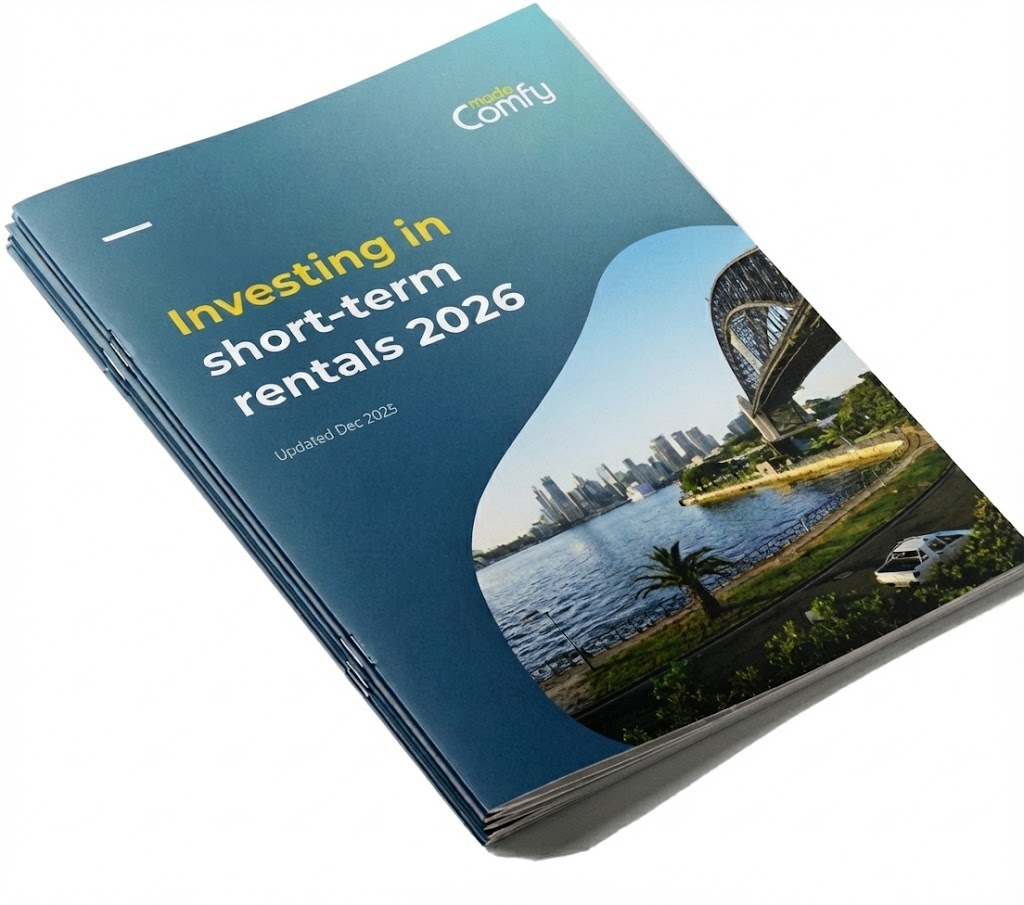Negative Gearing & Short-Term Rentals: What Every Australian Property Investor Should Know

Negative gearing has long been a hot topic for Australian property investors, and its impact is now under even closer scrutiny with the rapid growth of short-term rental platforms like Airbnb, Booking.com and Stayz. If you’re considering or already operating a short-term rental property, understanding how negative gearing works in this context is crucial to maximising your investment returns while complying with evolving ATO regulations.
What is Negative Gearing?
Negative gearing occurs when your total property-related expenses exceed the rental income you earn in a financial year, generating a loss. In Australia, this loss can be deducted from your other taxable income, often reducing your overall tax bill. This strategy is popular as it can help ease short-term cash flow pressures and support long-term capital growth ambitions.
How Negative Gearing Works (Step-by-Step Example)
- Calculate all income from your property: Include earnings from all sources (traditional tenants or short-term stays via platforms like Airbnb).
- Subtract all allowable expenses: Deduct costs such as management fees, cleaning, utilities, council rates, insurance, repairs and maintenance, depreciation, mortgage interest, and marketing expenses.
- If expenses exceed income, you have a negative-geared property. For example:
- Income: $30,000/year
- Deductible expenses: $36,000/year
- Net position: $6,000 loss (which can reduce tax on your salary or other income)
Negative Gearing: Short-Term vs Long-Term Rentals
While the negative gearing mechanism remains the same for both traditional and short-term rentals, key differences exist:
- Short-term rentals often generate higher potential income due to nightly pricing, especially during high-demand periods. However, they also attract higher expenses, such as more frequent cleaning, linen, and property management fees.
- Active management is essential: Unlike long-term rentals, short-term lets require ongoing guest communications, dynamic pricing, and rapid maintenance response. This can mean higher ongoing costs, but also greater flexibility and higher peak-season returns.
- ATO compliance and apportionment: You can only deduct expenses for periods your property was genuinely available for rent. If you use the property yourself or block out dates for personal use, you must apportion deductions accordingly.
What Can You Claim on Short-Term Rentals?
The ATO allows investors to deduct a wide range of expenses, provided they relate to income-production and are substantiated by records.
- Property and letting management fees
- Cleaning, linen, and laundry costs
- Repairs & maintenance
- Utilities (electricity, water, gas)
- Council rates, insurance
- Marketing & booking platform costs
- Depreciation (building and furnishings)
- Mortgage interest
Tip: Keep meticulous records for all expenses and periods both let and used privately. The ability to substantiate claims is crucial in the event of an ATO audit.
Key Benefit: Personal Use Flexibility
A standout advantage of the short-term rental model is the freedom to use your property yourself when it isn’t occupied by paying guests. This dual-use strategy offers both financial returns and lifestyle perks:
- Enjoy your property as a personal holiday home, while still generating income the rest of the year.
- Maximise earning potential by blocking dates for your own stays during quieter periods, or letting the property at higher rates during peak demand.
- Continue to claim deductions for the proportion of the year the property is genuinely let or available for rent. You must apportion expenses so that only the costs attributable to the income-producing periods are claimed.
Example: Apportioning Expenses
If you rent out your property for 39 weeks and use it yourself for 13 weeks, you can generally claim only 75% (39/52 weeks) of the allowable expenses. This ensures that tax deductions reflect income-generating use only.
Why Consider Negative Gearing for Short-Term Rentals?
- Tax benefits: Optimise cash flow by offsetting short-term losses against other taxable income.
- Potential for higher gross yields: Short-term lets can outperform long-term tenancies in strong tourism or event-driven markets, especially with expert management.
- Flexibility to use your property: Enjoy your investment when it suits you, or rent it out on your preferred schedule.
How MadeComfy Maximises Your Negative Gearing Benefits
Short-term rentals can be both lucrative and complex to manage. MadeComfy is Australia’s leading specialist in this space, partnering with investors to:
- Maximise occupancy and nightly rates through dynamic pricing
- Professionally coordinate cleaning, guest communication, and maintenance
- Accurately track all claimable expenses and generate clear annual financial statements for your tax agent
- Guide you on compliance with the latest ATO rules for short-term rentals
- Seamlessly accommodate your own use of the property alongside rental income
Key Questions - 15 Answered:
1. What is negative gearing in the context of Australian property investment?
From my understanding, negative gearing happens when the total costs of owning and managing my rental property—like mortgage interest, maintenance, and management fees—are higher than the rental income it generates. This results in a loss for tax purposes, which I can then deduct from my other income, helping reduce my overall tax payable.
2. How can negative gearing reduce an investor’s overall tax bill?
Because the loss on my rental property (where expenses exceed income) is tax-deductible, I can offset this loss against my other taxable income, such as my salary. This reduces my taxable income and lowers the amount of tax I owe, effectively improving my cash flow while I build equity in the property.
3. In a negatively geared property, what typically exceeds rental income?
Usually, the mortgage interest payments, plus costs like property management fees, cleaning, repairs, utilities, and depreciation expenses, collectively add up to more than the rental income I receive, creating that negative gearing loss.
4. Name three deductible expenses that Australian investors can claim on short-term rental properties.
I can claim expenses such as property management fees, cleaning and laundry costs between guests, and utilities like electricity and water, as long as they relate to the periods my property is genuinely available for rent.
5. How do short-term rentals generally differ from long-term rentals in terms of income potential and expenses?
Short-term rentals tend to earn higher revenue because I can charge a nightly rate and adjust pricing based on demand or local events. However, they also come with higher and more frequent expenses, like regular cleaning, guest communication time, dynamic pricing software, and increased wear and tear, meaning my operating costs are usually higher compared to long-term rentals.
6. Why is keeping detailed records important when claiming tax deductions on short-term rentals?
The ATO requires me to prove my claims, so detailed records help me separate rental-related expenses from personal use or vacant periods. Proper documentation ensures I only claim legitimate deductions and reduces audit risk. This includes receipts, invoices, and records showing when the property was rented versus used personally.
7. What is a key difference in management between short-term rental properties and traditional long-term rental properties?
Unlike traditional rentals where tenants stay long-term, short-term rentals demand ongoing, active management including managing bookings, guest communications, cleaning between stays, and dynamic pricing adjustments. This means daily oversight or professional property management is often necessary.
8. Can an investor claim negative gearing deductions for periods when they use the property personally? Explain briefly.
No. The ATO only allows deductions for expenses incurred during times when the property is genuinely rented or available for rent. If I use the property personally, I must apportion my expenses to exclude those periods from my claims to comply with tax laws.
9. How does apportioning expenses work if a property is used both for personal use and rental during the year?
I calculate the proportion of time the property was rented or available for rent versus personal use. Then, I apply this percentage to my deductible expenses. For instance, if the property was rented 40 weeks and personally used 12 weeks, I’d claim deductions on about 77% of my eligible expenses.
10. What role does professional management, like MadeComfy’s services, play in maximizing rental income and tax benefits?
Professional managers streamline guest communications, cleaning, maintenance, and pricing strategies to maximise revenue and occupancy. They also help track deductible expenses accurately and ensure compliance with ATO requirements. This allows me to focus on the investment’s financial performance without getting bogged down in day-to-day operations.
11. Why might short-term rentals offer a more flexible investment compared to long-term rentals?
Short-term rentals let me use the property personally during unbooked periods or block out dates for my use, giving a blend of financial return and lifestyle benefits—unlike long-term tenants where the property must be leased continuously.
12. What is the potential risk if a property owner does not comply with ATO rules about rental expenses?
If I overclaim expenses or fail to correctly apportion personal use, I risk ATO audits, penalties, and having to repay owed tax plus interest. Accurate claims and recordkeeping are crucial to avoid costly compliance issues.
13. Describe a scenario where negative gearing might be strategically used by an investor with a short-term rental.
If I purchase a property in a tourist hotspot, I may accept a short-term negative cash flow initially due to mortgage interest and operational costs, counting on tax deductions and capital growth to build long-term wealth. The higher rental returns during peak seasons can reduce losses, while the tax offsets improve my overall financial position.
14. How does dynamic pricing impact the income potential of short-term rentals?
Dynamic pricing tools help me adjust nightly rates based on demand, events, and seasonality, maximising occupancy and revenue. Effective pricing reduces vacancy and can increase overall rental income, helping to minimise the gap between rental income and expenses.
15. Why is consulting a tax professional recommended for investors using negative gearing strategies?
Tax professionals understand the latest ATO rules, can help optimise my deductions legally, ensure proper expense apportionment, and keep me audit-ready. Their advice is crucial since tax laws around short-term rentals can be complex and change regularly.
Next Steps: Get Personalised Short-Term Rental Advice
Negative gearing can be a powerful component of your property strategy, especially when tailored to the fast-moving short-term rental market. Given the scrutiny by the ATO and policymakers, it’s essential to stay compliant and make informed, data-driven decisions.
Thinking about maximising your investment returns and enjoying the flexibility of short-term rental ownership? Contact MadeComfy today for tailored guidance and professional management that ensures you get the most from both your property and your tax strategy.
Disclaimer: This article is for educational purposes only and does not constitute financial or tax advice. Investors should consult a qualified tax adviser or accountant for advice specific to their individual circumstances.


























